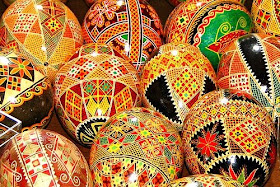I may have forgotten to mention that I'm at least 1/4 Ukrainian. And one of the ways we've been keeping some traditions alive is by making Ukrainian Easter Eggs or "Pysanky" (PUH san keh).
These beautiful, detailed, and vibrant eggs are one of the few traditions that i look forward to every single year. Not because i believe that they have one lick to do with Easter, but because they are a very fun tedious craft project and have been a bonding time for me and my mother.
As with many non-Christian cultures, the eggs were originally a part of a spring festival and meant to symbolize new life (much more appropriate than the Easter bunny IMO). They are packed full with symbolism, meanings, and patterns and typically given as gifts. Later, it joined with the Christian holiday of Easter and thus became more commonly known as the Ukrainian Easter Egg. That's the short version.
In my family, this skill was ironically passed down to me from my mother (who is not the source of my Ukrainian heritage). But she is the artsy one in my family besides me and she loves cultural history. It became a week long ordeal with me sitting there obsessing over a design for hours, as she worked on her own.
These eggs cannot be re-created with those egg dying kits you get at the grocery store. In those, you draw on them with the wax crayon in order to prevent the dye from sticking to certain parts. Also the dye tablets are by FAR too weak for these designs.
Pysanky is similar in this concept but much more complicated.
With a Kistka (stylis) you melt beeswax and then draw part of your design on the egg. Anywhere that the wax covers will be white when you're done. You then dip the egg in the first dye, which is usually yellow. Once the dye is set, you take it out and draw in other areas with the Kistka. When done, these parts will be yellow. You continue this process, gradually filling in the egg with beeswax and using darker and darker dyes until the final color: Black.
At this point, you use a strong pin to break in a small hole at the top and the bottom of the egg and blow the yoke out of the egg so it becomes hollow. This is somewhat gross, but the results are worth the effort and tired cheeks.
It's also interesting to see how the design turns out since you're working your color scheme backwards. Because the beeswax comes out of the Kistka black it takes a little adjusting in your brain to remember that that part will be white (or another color) in the end. It's also very difficult drawing on a non flat surface.
I gotta go through the dye packets we have and then make a trip to the store to buy whatever we don't have, but probably starting this weekend, i'll begin the process for this year.

No comments:
Post a Comment
<$CommentPager$>